UV-Index Climatology for Europe Based on Satellite Data
Abstract
1. Introduction
2. Materials and Methods
2.1. UVI Climatology Based on Satellite Data
2.2. Comparison of UVI Climatology with Ground-Based Measurements
3. Results
3.1. Mean Monthly UVI of Europe
3.2. UVI Overview for Chosen Locations
3.3. Relative Frequency and Absolute Number of UVI Classes
3.4. Temporal Changes of UVI
3.5. Comparison of UVI Climatology with Ground-Based Measurements
4. Discussion
5. Conclusions
Author Contributions
Funding
Acknowledgments
Conflicts of Interest
Abbreviations
| AOD | Aerosol optical depth |
| CAL | Effective cloud albedo |
| CMF | Cloud modification factor |
| CM SAF | Satellite Application Facility on Climate Monitoring |
| DWD | Deutscher Wetterdienst |
| EUMETSAT | European Organisation for the Exploitation of Meteorological Satellites |
| ICNIRP | International Commission on Non-Ionizing Radiation Protection |
| KNMI | Royal Netherlands Meteorological Institute |
| MVIRI | Meteosat visible and infrared imager |
| SDI | Surface incoming direct irradiance |
| SEVIRI | Spinning enhanced visible and infrared imager |
| SIS | Surface incoming solar radiation |
| SRI | Spectrally resolved irradiance |
| SZA | Solar zenith angle |
| TEMIS | Tropospheric Emission Monitoring Internet Service |
| UNEP | United Nations Environment Programme |
| UVI | UV-Index |
| UV | Ultraviolet |
| WHO | World Health Organization |
| WMO | World Meteorological Organization |
References
- Damiani, A.; Cordero, R.R.; Cabrera, S.; Laurenza, M.; Rafanelli, C. Cloud cover and UV index estimates in Chile from satellite-derived and ground-based data. Atmos. Res. 2014, 138, 139–151. [Google Scholar] [CrossRef]
- National Radiological Protection Board. Health Effects from Ultra-Violet Radiation: Report of an Advisory Group on Non-Ionising Radiation; Documents of the NRPB; Public Health England: London, UK, 2002; pp. 13–19. [Google Scholar]
- Slaper, H.; Velders, G.J.M.; Daniel, J.S.; Degruijl, F.R.; Vanderleun, J.C. Estimates of ozone depletion and skin cancer incidence to examine the Vienna convention achievements. Nature 1996, 384, 256–258. [Google Scholar] [CrossRef] [PubMed]
- Calbó, J.; Pagès, D.; González, J.-A. Empirical studies of cloud effects on UV radiation: A review. Rev. Geophys. 2005, 43. [Google Scholar] [CrossRef]
- Holick, M.F. Sunlight, UV-Radiation, Vitamin D and Skin Cancer: How Much Sunlight Do We Need. In Sunlight, Vitamin D and Skin Advances in Experimental Medicine and Biology; Reichrath, J., Ed.; Springer: New York, NY, USA, 2008; Volume 624. [Google Scholar] [CrossRef]
- Lityńska, Z.; Köpke, P.; De Backer, H.; Gröbner, J.; Schmalwieser, A.W.; Vuilleumier, L. Long term changes and climatology of UV radiation over Europe. In COST Action 726—Final Scientific Report; European Union: Luxembourg, 2012; p. 128. [Google Scholar]
- Armstrong, B.K.; Kricker, A. The epidemiology of UV induced skin cancer. J. Photochem. Photobiol. B. 2001, 63, 8–18. [Google Scholar] [CrossRef]
- WHO World Health Organization. Global Solar UV Index: A Practical Guide. A Joint Recommendation of the World Health Organization, World Meteorological Organization, United Nations Environmental Programme, and the International Commission on Non-Ionizing Radiation Protection; World Health Organization: Geneva, Switzerland, 2002; ISBN 92-4-159007. [Google Scholar]
- CIE International Commission on Illumination. A Reference Action Spectrum for Ultraviolet Induced Erythema in Human Skin; Elsevier Science Publishers: Amsterdam, The Netherlands, 1987; pp. 17–22. [Google Scholar]
- WHO World Health Organization. Ultraviolet Radiation. Environmental Health Criteria (EHC) 160; WHO World Health Organization: Geneva, Switzerland,, 1994. [Google Scholar]
- WMO (World Meteorological Organization). Assessment for Decision-Makers: Scientific Assessment of Ozone Depletion: 2014; Global Ozone Research and Monitoring Project—Report No. 56; WMO: Geneva, Switzerland, 2014; p. 88. [Google Scholar]
- Bais, A.F.; Bernhard, G.; McKenzie, R.L.; Aucamp, P.J.; Young, P.J.; Ilyas, M.; Jöckel, P.; Deushi, M. Ozone-climate interactions and effects on solar ultraviolet radiation. Photochem. Photobiol. Sci. 2019, 18, 602–640. [Google Scholar] [CrossRef]
- Staiger, H.; den Outer, P.N.; Bais, A.F.; Feister, U.; Johnsen, B.; Vuilleumier, L. Hourly resolved cloud modification factors in the ultraviolet. Atmos. Chem. Phys. 2008, 8, 2493–2508. [Google Scholar] [CrossRef]
- Kelfkens, G.; den Outer, P.N.; Slaper, H. Risks and Ultraviolet Budgets Using Earth Observation (RUBEO): Including a Non-Standard Atmosphere and Geographic Ozone Trend Differences in Risk Assessments; USP-2 01-33, USP-2 Project 4.1/DE-02; Netherlands Remote Sensing Board (BCRS): Delft, The Netherlands, 2001; pp. 1–82. ISBN 90 54 11 378 2. [Google Scholar]
- Krzyścin, J.W.; Puchalski, S. Aerosol impact on the surface UV radiation from the ground-based measurements taken at Belsk, Poland, 1980–1996. J. Geophys. Res. 1998, 103, 16175–16181. [Google Scholar] [CrossRef]
- Blumthaler, M.; Ambach, W.; Ellinger, R. Increase in solar UV radiation with altitude. J. Photochem. Photobiol. B. 1997, 39, 130–134. [Google Scholar] [CrossRef]
- Pfeifer, M.T.; Köpke, P.; Reuder, J. Effects of altitude and aerosol on UV radiation. J. Geophys. Res. 2006, 111, D01203. [Google Scholar] [CrossRef]
- Sola, Y.; Lorente, J.; Campmany, E.; de Cabo, X.; Bech, J.; Redano, A.; Martinez-Lozano, J.A.; Utrillas, M.P.; Alados-Arboledas, L.; Olmo, F.J.; et al. Altitude effect in UV radiation during the Evaluation of the Effects of Elevation and Aerosols on the Ultraviolet Radiation 2001 (VELETA-2002) field campaign. J. Geophys. Res. 2008, 113, D23. [Google Scholar] [CrossRef]
- Fountoulakis, I.; Bais, A.F.; Fragkos, K.; Meleti, C.; Tourpali, K.; Zempila, M.M. Short- and long-term variability of spectral solar UV irradiance at Thessaloniki, Greece: Effects of changes in aerosols, total ozone and clouds. Atmos. Chem. Phys. 2016, 16, 2493–2505. [Google Scholar] [CrossRef]
- Fountoulakis, I.; Diémoz, H.; Siani, A.-M.; Laschewski, G.; Filippa, G.; Arola, A.; Bais, A.F.; De Backer, H.; Lakkala, K.; Webb, A.R.; et al. Solar UV Irradiance in a Changing Climate: Trends in Europe and the Significance of Spectral Monitoring in Italy. Environments 2020, 7, 1. [Google Scholar] [CrossRef]
- Schmalwieser, A.W.; Hirschmann, G.; Cabaj, A.; Sommer, R. Method to determine the power efficiency of UV disinfection plants and its application to low pressure plants for drinking water. Water Sci. Technol. Water Supply 2017, 17, 947–957. [Google Scholar] [CrossRef]
- Herman, J.R.; Krotkov, N.; Celarier, E.; Larko, D.; Labow, G. Distribution of UV radiation at the Earth´s surface from TOMS-measured UV-backscattered radiances. J. Geophys. Res. Atmos. 1999, 104, 12059–12076. [Google Scholar] [CrossRef]
- Ialongo, I.; Arola, A.; Kujanpää, J.; Tamminen, J. Use of satellite erythemal UV products in analysing the global UV changes. Atmos. Chem. Phys. 2011, 11, 9649–9658. [Google Scholar] [CrossRef]
- Ziemke, J.; Chandra, S.; Herman, J.; Varotsos, C. Erythemal weighted UV trends over northern latitudes derived from NIMBUS 7 TOMS measurements. J. Geophys. Res. 2000, 105, 7373–7382. [Google Scholar] [CrossRef]
- Chen, Y.-C. UV and Aerosol Climatology Based on Simulations and Measurements by Satellites and Ground Station. Ph.D. Thesis, Department of Physics and Technology, University of Bergen, Bergen, Norway, 2012. [Google Scholar]
- Fioletov, V.E.; Kimlin, M.G.; Krotkov, N.; McArthur, L.J.B.; Kerr, J.B.; Wardle, D.I.; Herman, J.R.; Meltzer, R.; Mathews, T.W.; Kaurola, J. UV index climatology over the United States and Canada from ground-based and satellite estimates. J. Geophys. Res. 2004, 109, D22308. [Google Scholar] [CrossRef]
- Verdebout, J. A satellite-derived UV radiation climatology over Europe to support impact studies. Arct. Antarct. Alp. Res. 2004, 36, 357–363. [Google Scholar] [CrossRef][Green Version]
- Van Geffen, J.; van Weele, M.; Allaart, M.; Eskes, H. Surface UV radiation monitoring based on GOME and SCIAMACHY. In Proceedings of the ENVISAT & ERS Symposium, Salzburg, Austria, 6–10 September 2004. [Google Scholar]
- Van Weele, M.; van der A, R.J.; van Geffen, J.; Roebeling, R. Space-based surface UV monitoring for Europe using SCIAMACHY and MSG. In Proceedings of the 12th SPIE International Symposium on Remote Sensing, Bruges, Belgium, 19–22 September 2005. [Google Scholar]
- Zempila, M.M.; van Geffen, J.H.G.M.; Taylor, M.; Fountoulakis, I.; Koukouli, M.E.; van Weele, M.; van der A, R.J.; Bais, A.; Meleti, C.; Balis, D. TEMIS UV product validation using NILU-UV ground-based measurements in Thessaloniki. Atmos. Chem. Phys. 2017, 17, 7157–7174. [Google Scholar] [CrossRef]
- Van Geffen, J.; van Weele, M.; Allaart, M. TEMIS UV Index and UV Dose MSR-2 Data Products, Version 2. Dataset; Royal Netherlands Meteorological Institute (KNMI): De Bilt, The Netherlands, 2017. [Google Scholar] [CrossRef]
- Allaart, M.; van Weele, M.; Fortuin, P.; Kelder, H. An Empirical model to predict the UV-index based on Solar Zenith Angle and Total Ozone. Meteorol. Appl. 2004, 11, 59–65. [Google Scholar] [CrossRef]
- Allaart, A.F.; Eskes, H.J. Extended and refined multi sensor reanalysis of total ozone for the perion 1970–2012. Atmos. Meas. Tech. 2015, 8, 3021–3035. [Google Scholar] [CrossRef]
- Herman, J.R.; Celarier, E.A. Earth surface reflectivity climatology at 340–380 nm from TOMS data. J. Geophys. Res. 1997, 102, 28003–28011. [Google Scholar] [CrossRef]
- Badosa, J.; van Weele, M. Effects of Aerosols on UV Index; KNMI Scientific Report WR-2002-07; Royal Netherlands Meteorological Institute (KNMI): De Bilt, The Netherlands, 2002. [Google Scholar]
- Kelfkens, G.; Bregman, A.; de Gruijl, F.; van der Leun, J.; Piquet, A.; van Oijen, T.; Gieskes, W.; Loveren, H.; Velders Guus, J.M.; Martens, P.; et al. Ozone Layer-Climate Change Interactions. Influence on UV Levels and UV Related Effects; Dutch National Research Programme on Global Air Pollution and Climate Change, Report 410 200 112; National Institute for Public Health and the Environment (RIVM): Bilthoven, The Netherlands, 2002; ISBN 90 5851 079 4. [Google Scholar]
- Gröbner, J.; Albold, A.; Blumthaler, M.; Cabot, T.; De la Casiniere, A.; Lenoble, J.; Martin, T.; Masserot, D.; Müller, M.; Philipona, R.; et al. Variability of spectral solar ultraviolet irradiance in an Alpine environment. J. Geophys. Res. 2000, 26, 991–1027. [Google Scholar] [CrossRef]
- den Outer, P.N.; Slaper, H.; Tax, R.B. UV radiation in the Netherlands: Assessing long-term variability and trends in relation to ozone and clouds. J. Geophys. Res. Atmos. 2005, 110. [Google Scholar] [CrossRef]
- Schulz, J.; Thomas, W.; Müller, R.; Behr, H.-D.; Caprion, D.; Deneke, H.; Dewitte, S.; Dürr, B.; Fuchs, P.; Gratzki, A.; et al. Operational climate monitoring from space: The EUMETSAT satellite application facility on climate monitoring (CM-SAF). Atmos. Chem. Phys. Discuss. 2008, 8, 8517–8563. [Google Scholar] [CrossRef]
- Cano, D.; Monget, J.M.; Albuisson, M.; Guillard, H.; Regas, N.; Wald, L. A method for the determination of the global solar-radiation from meteorological satellite data. Sol. Energy 1986, 37, 31–39. [Google Scholar] [CrossRef]
- Posselt, R.; Mueller, R.W.; Stöckli, R.; Trentmann, J. Remote sensing of solar surface radiation for climate monitoring—The CM-SAF retrieval in international comparison. Remote Sens. Environ. 2012, 118, 186–198. [Google Scholar] [CrossRef]
- Hammer, A.; Heinemann, D.; Hoyer, C.; Kuhlemann, R.; Lorenz, E.; Müller, R.; Beyer, H.G. Solar energy assessment using remote sensing technologies. Remote Sens. Environ. 2003, 86, 423–432. [Google Scholar] [CrossRef]
- EUMETSAT. Meteosat Solar Surface Radiation and Effective Cloud Albedo Climate Data Record SARAH-2; EUMETSAT: Darmstadt, Germany, 2016. [Google Scholar] [CrossRef]
- Fountoulakis, I.; Diémoz, H.; Siani, A.M.; Hülsen, G.; Gröbner, J. Monitoring of solar spectral ultraviolet irradiance in Aosta, Italy. Earth. Sys. Sci. Data Discuss. 2020. accepted. [Google Scholar]
- Webb, A.R.; Slaper, H.; Koepke, P.; Schmalwieser, A.W. Know Your Standard: Clarifying the CIE 1140 Erythema Action Spectrum. Photochem. Photobiol. 2011, 87, 483–486. [Google Scholar] [CrossRef]
- Hülsen, G.; Gröbner, J.; Nevas, S.; Sperfeld, P.; Egli, L.; Porrovecchio, G.; Smid, M. Traceability of solar UV measurements using the Qasume reference spectroradiometer. Appl. Opt. 2016, 55, 7265–7275. [Google Scholar] [CrossRef] [PubMed]
- Johnsen, B. Intercomparison and harmonization of UV Index measurements from multiband filterradiometers. J. Geophys. Res. 2008, 113, D15206. [Google Scholar] [CrossRef]
- Schmalwieser, A.W.; Gröbner, J.; Blumthaler, M.; Klotz, B.; De Backer, H.; Bolsée, D.; Werner, R.; Tomsic, D.; Metelka, L.; Eriksen, P.; et al. UV Index monitoring in Europe. Photochem. Photobiol. Sci. 2017, 16, 1349–1370. [Google Scholar] [CrossRef] [PubMed]
- Gelaro, R.; McCarty, W.; Suárez, M.J.; Todling, R.; Molod, A.; Takacs, L.; Randles, C.A.; Darmenov, A.; Bosilovich, M.G.; Reichle, R.; et al. The Modern-Era Retrospective Analysis for Research and Applications, Version 2 (MERRA-2). J. Clim. 2017, 30, 5419–5454. [Google Scholar] [CrossRef] [PubMed]
- Lemus-Deschamps, L.; Rikus, L.; Grainger, S.; Gies, P.; Sisson, J.; Li, Z. UV Index and UV dose distributions for Australia (1997–2001). Aust. Met. Mag. 2004, 53, 239–250. [Google Scholar]
- Cadet, J.-M.; Bencherif, H.; Portafaix, T.; Lamy, K.; Ncongwane, K.; Coetzee, G.J.R.; Wright, C.Y. Comparison of Ground-Based and Satellite-Derived Solar UV Index Levels at Six South African Sites. Int. J. Environ. Res. Public Health 2017, 14, 1384. [Google Scholar] [CrossRef] [PubMed]
- UNEP (United Nations Environment Programme). Environmental Effects Assessment Panel: Environmental effects of ozone depletion and its interactions with climate change: Progress report, 2015. Photochem. Photobiol. Sci. 2016, 15, 141–174. [Google Scholar] [CrossRef]
- Bech, J.; Sola, Y.; Ossó, A.; Lorente, J. Analysis of 14 years of broadband ground-based solar UV index observations in Barcelona. Int. J. Climatol. 2015, 35, 45–56. [Google Scholar] [CrossRef]
- Eleftheratos, K.; Kazadzis, S.; Zerefos, C.S.; Tourpali, K.; Meleti, C.; Balis, D.; Zyrichidou, I.; Lakkala, K.; Feister, U.; Koskela, T.; et al. Ozone and Spectroradiometric UV Changes in the Past 20 Years over High Latitudes. Atmosphere-Ocean 2015, 53, 117–125. [Google Scholar] [CrossRef]
- Hunter, N.; Rendell, R.J.; Higlett, M.P.; O’Hagan, J.B.; Haylock, R.G.E. Relationship between erythema effective UV radiant exposure, total ozone, cloud cover and aerosols in southern England, UK. Atmos. Chem. Phys. 2019, 19, 683–699. [Google Scholar] [CrossRef]
- Van Dijk, A.; den Outer, P.; Slaper, H. Climate and Ozone Change Effects on Ultraviolet Radiation and Risks: Using a Validating Earth Observation; RIVM-Report 610002001; RIVM: Bilthoven, The Netherlands, 2008. [Google Scholar]
- Czerwińska, A.E.; Krzyścin, J.W. Climatological aspects of the increase of the skin cancer (melanoma) incidence rate in Europe. Int. J. Climatol. 2020, 40, 3196–3207. [Google Scholar] [CrossRef]
- Lamy, K.; Portafaix, T.; Josse, B.; Brogniez, C.; Godin-Beekmann, S.; Bencherif, H.; Revell, L.; Akiyoshi, H.; Bekki, S.; Hegglin, M.I.; et al. Clear-sky ultraviolet radiation modelling using output from the Chemistry Climate Model Initiative. Atmos. Chem. Phys. 2019, 19, 10087–10110. [Google Scholar] [CrossRef]
- Den Outer, P.N.; Slaper, H.; Kaurola, J.; Lindfors, A.; Kazantzidis, A.; Bais, A.F.; Feister, U.; Junk, J.; Janouch, M.; Josefsson, W. Reconstructing of erythemal ultraviolet radiation levels in Europe for the past 4 decades. J. Geophys. Res. 2010, 115, D10102. [Google Scholar] [CrossRef]
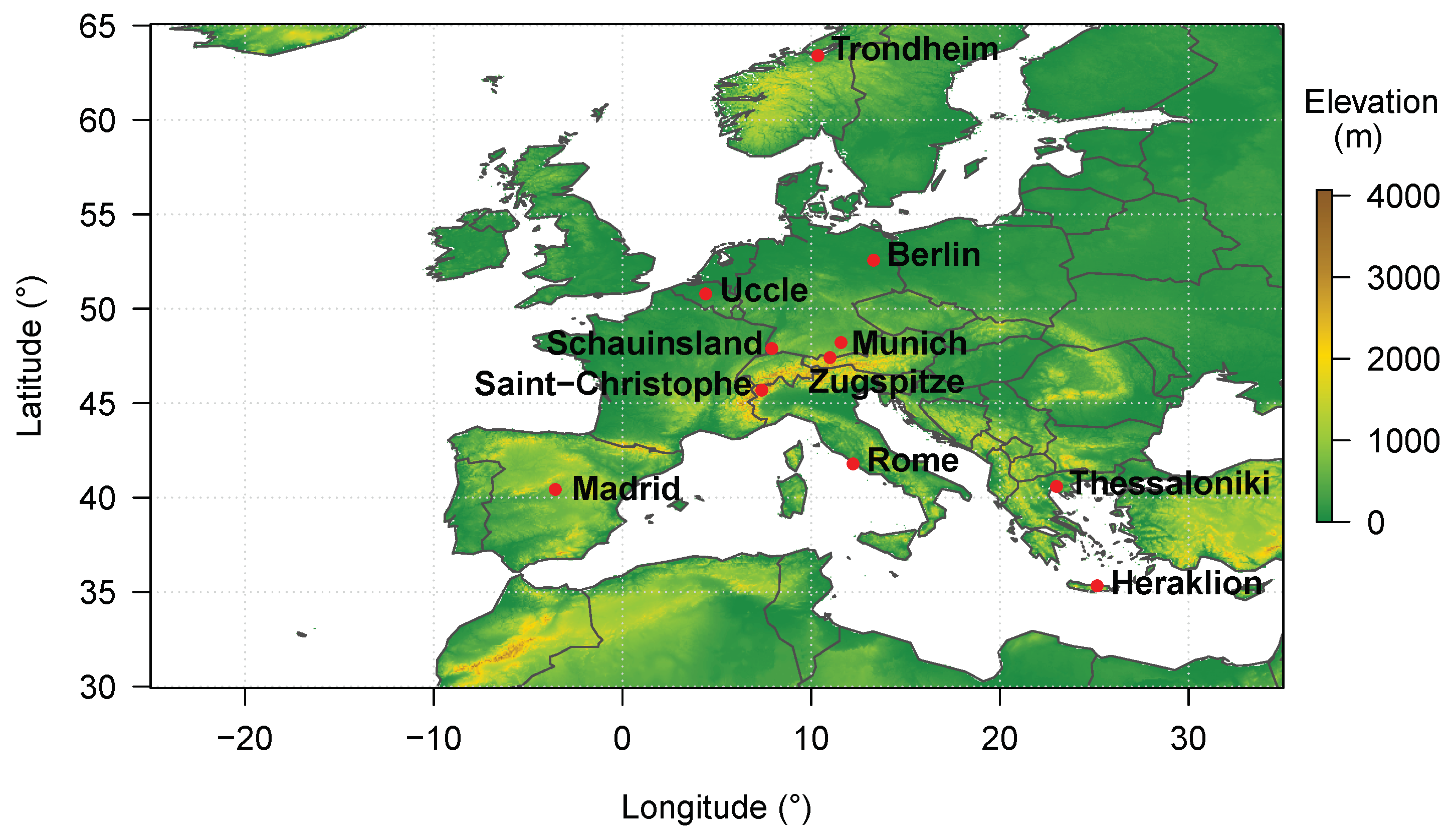

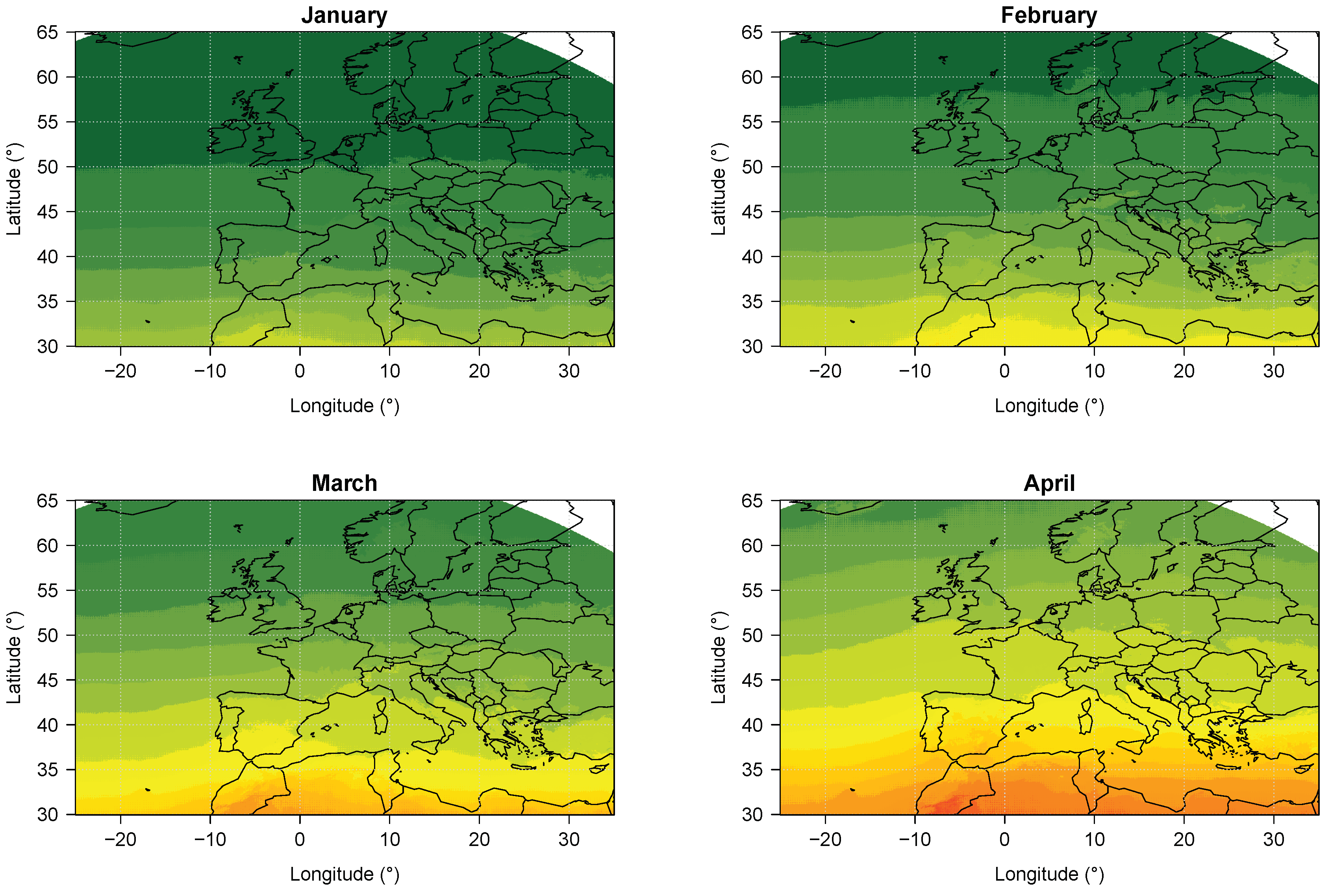
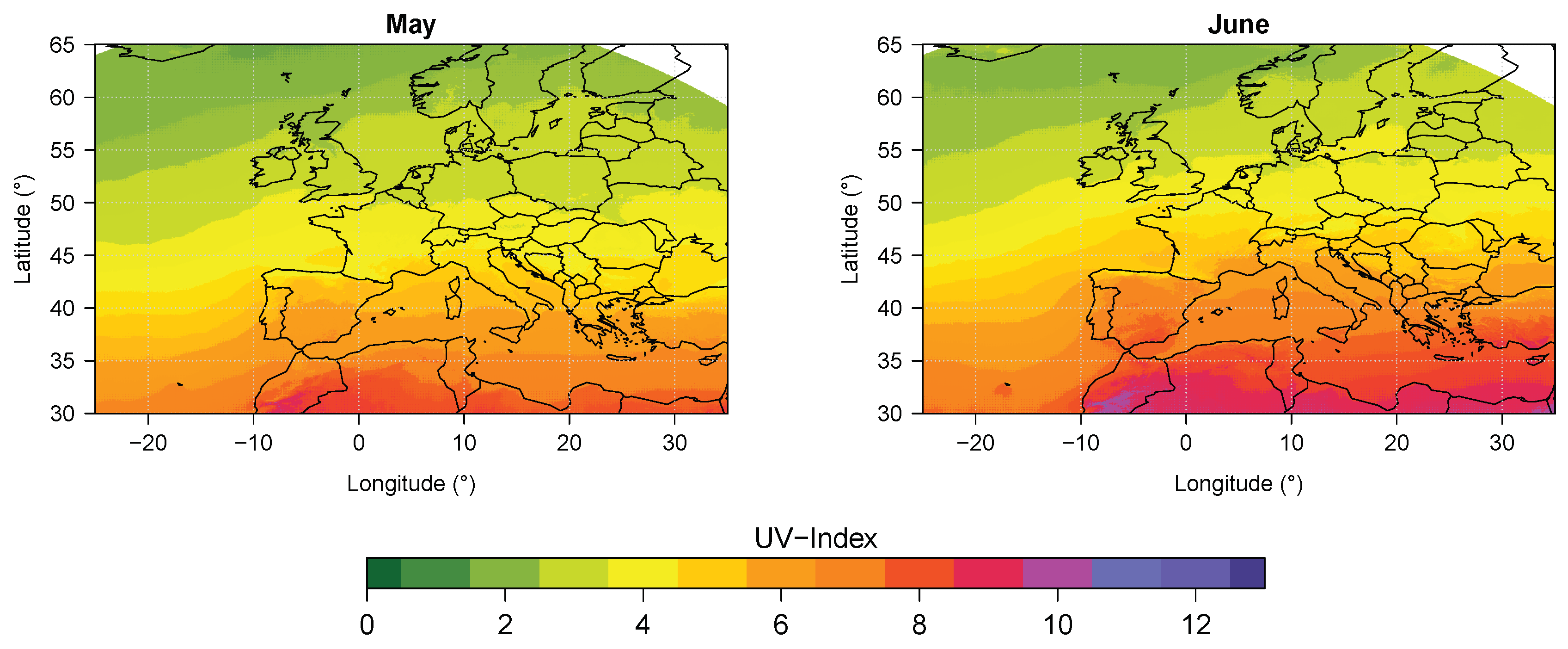
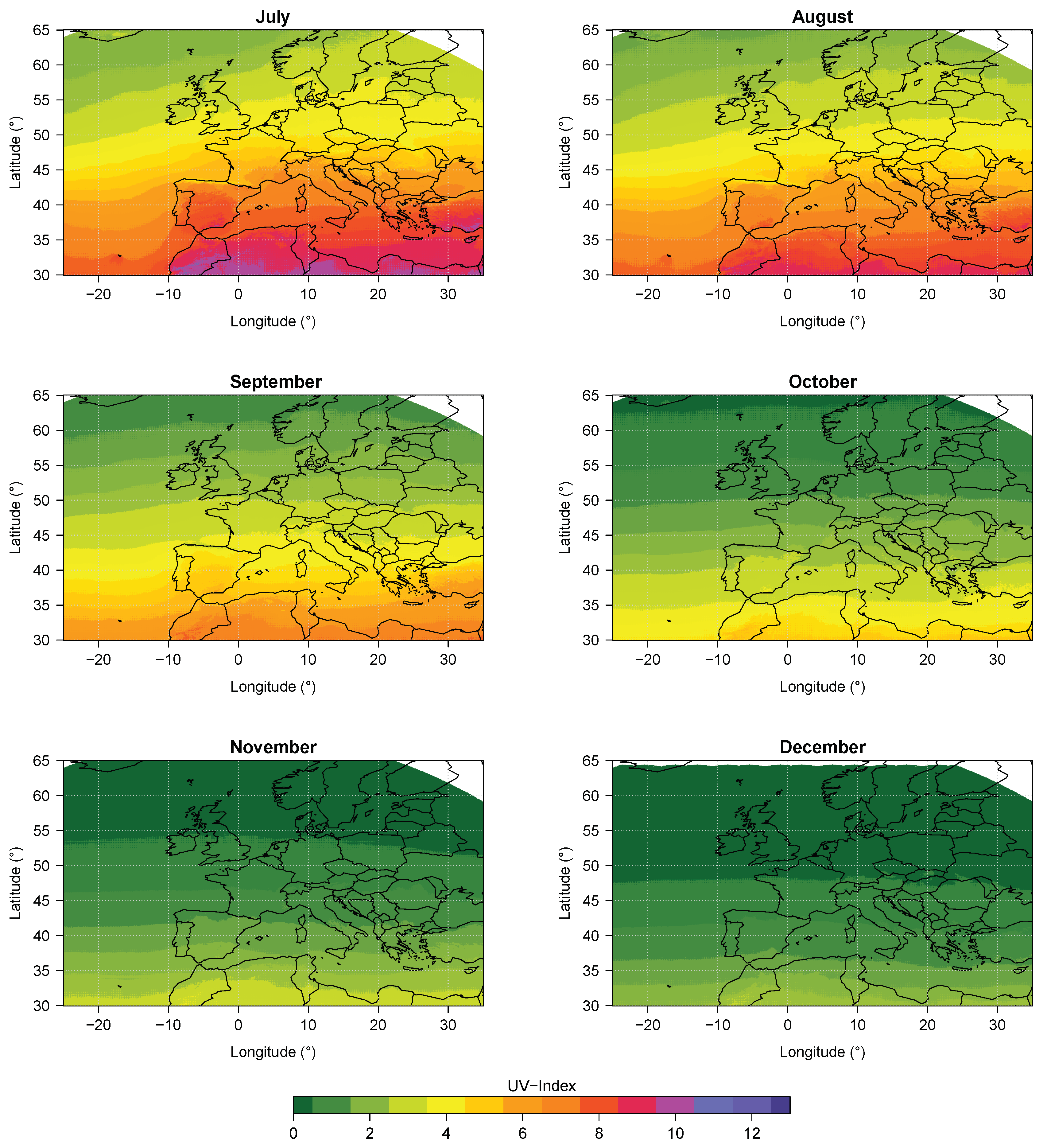


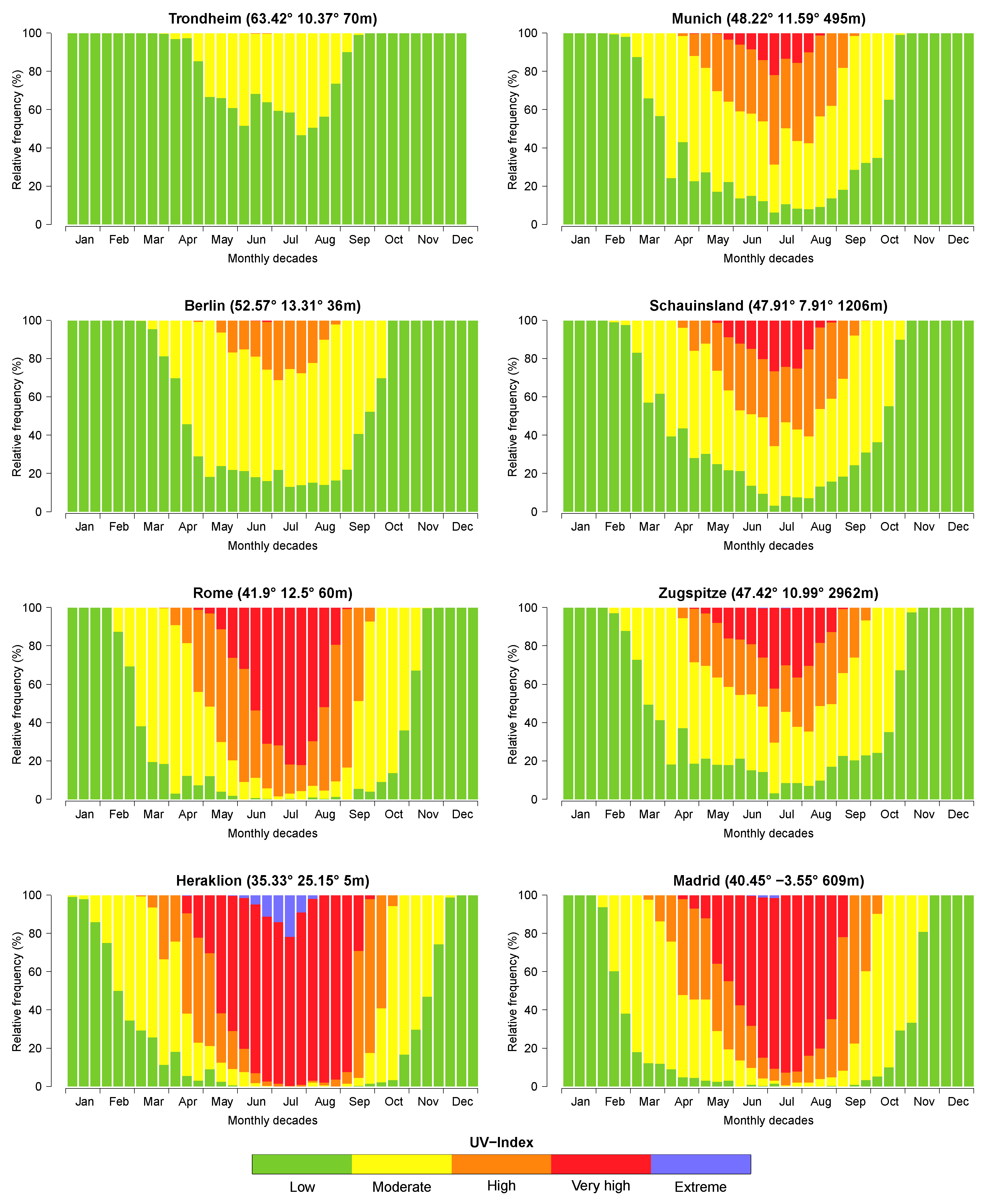

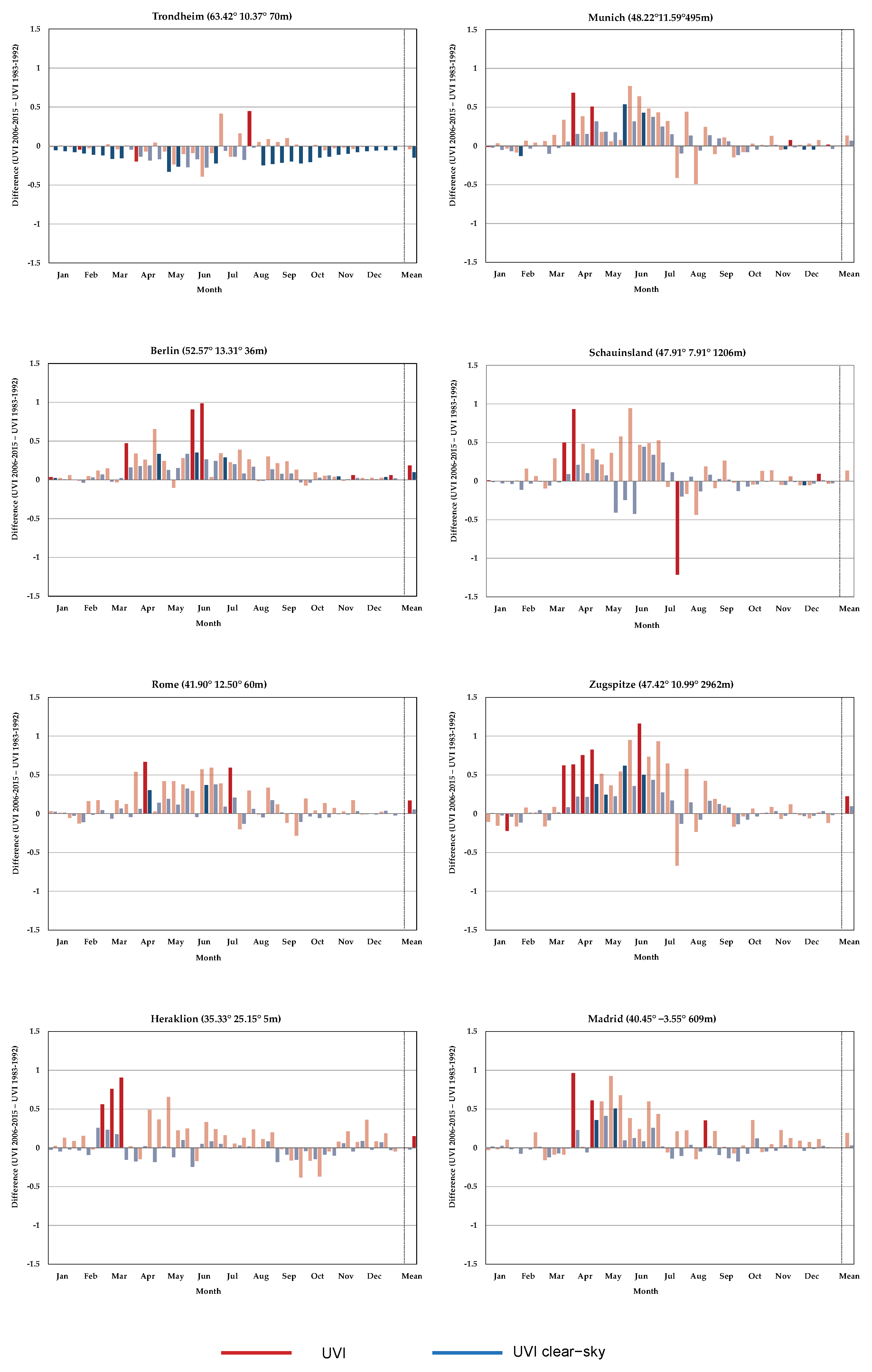
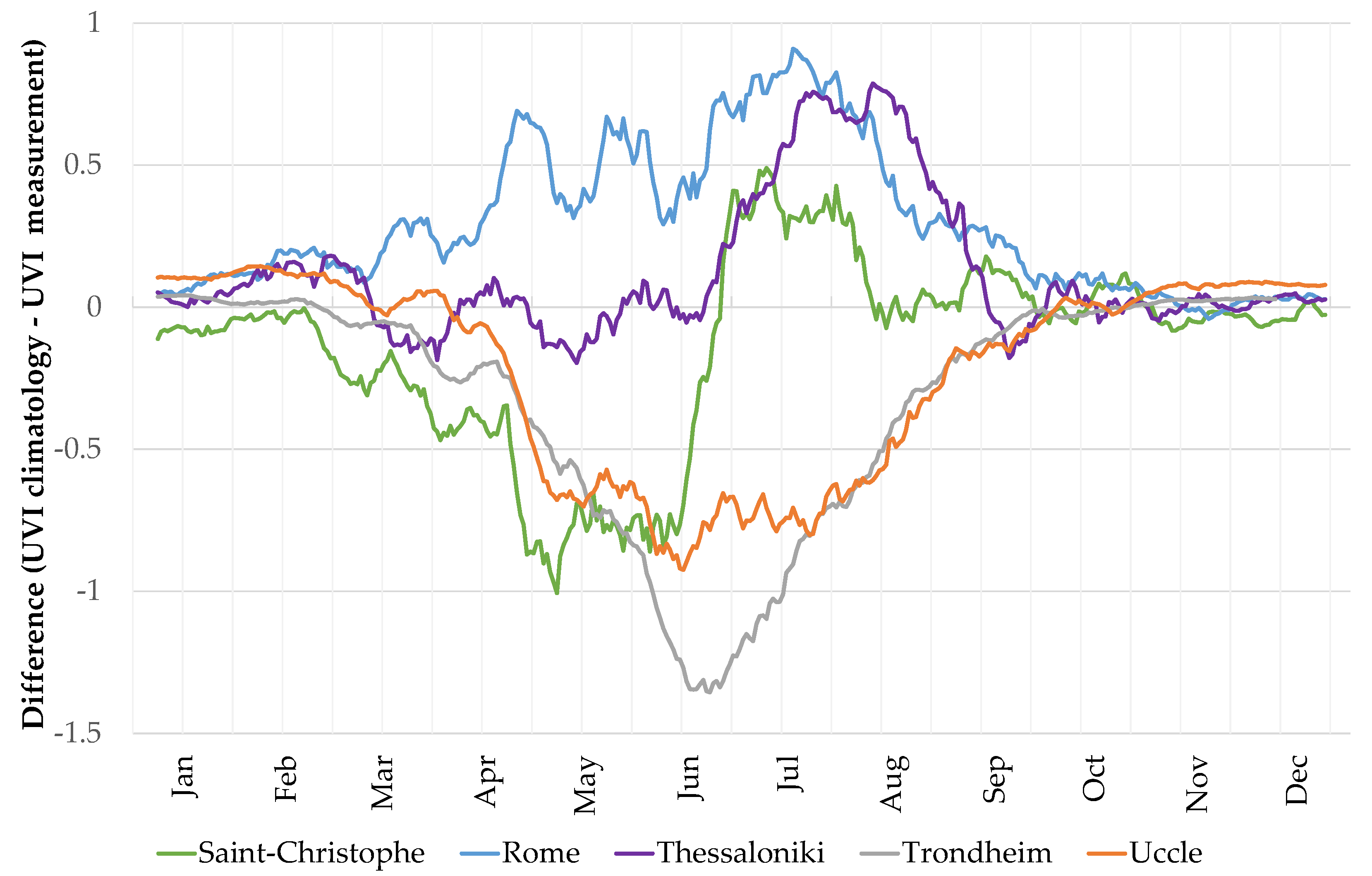
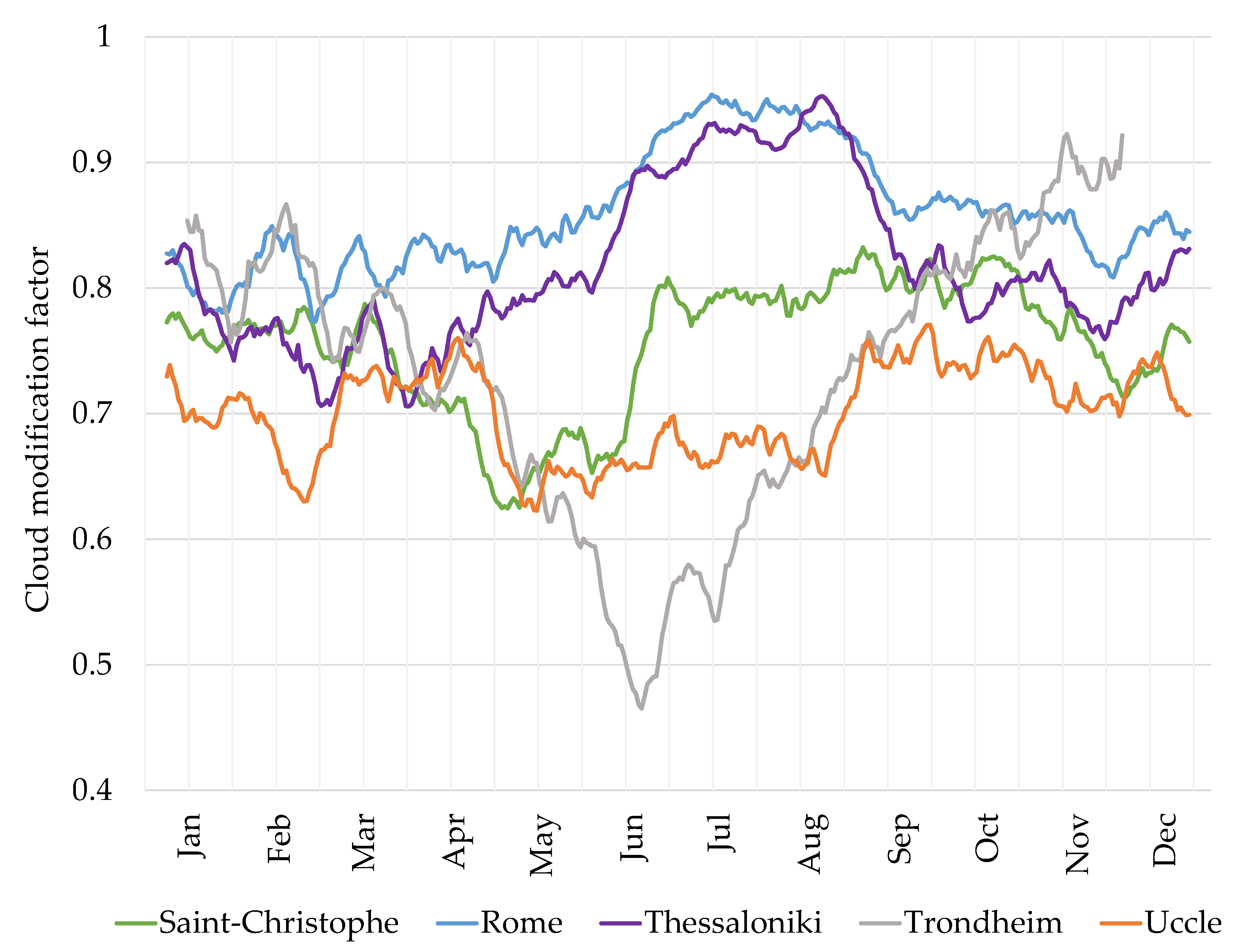
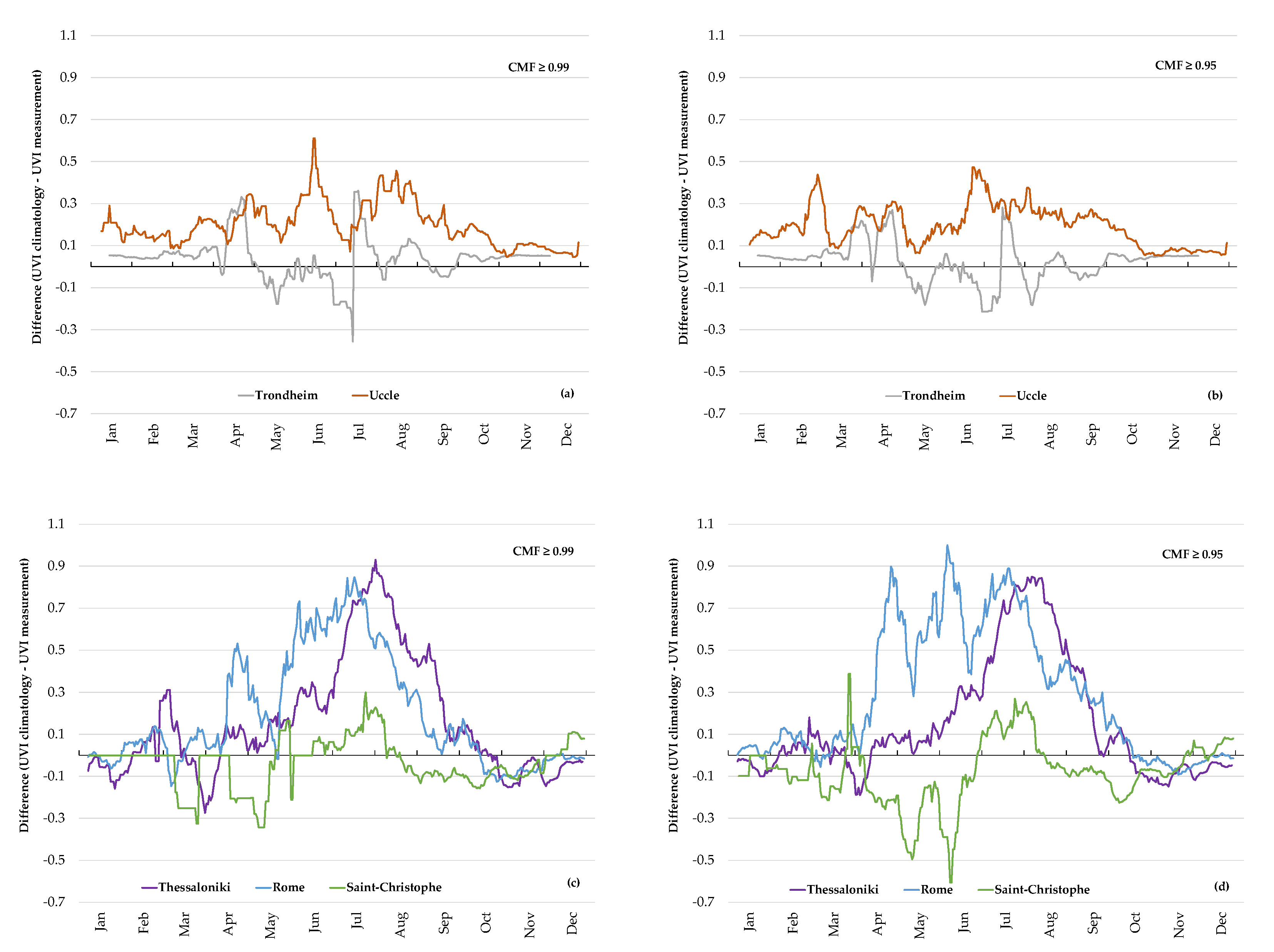
| Solar Zenith Angle | Parameter p |
|---|---|
| 25.8–41.4 | 0.383 |
| 41.4–53.1 | 1.07 |
| 53.1–63.3 | 1.94 |
| 63.3–72.5 | 3.03 |
| 72.5–81.4 | 4.40 |
| >81.4 | 6.13 |
| Name of the | Latitude, | Surface | Type of | Instrument | (Start of | Data |
|---|---|---|---|---|---|---|
| Station | Longitude, | Description | Measure- | Model | Measurement)/ | Source |
| Altitude | Ment | # Serial | Availability | |||
| Number | Since | |||||
| Rome | 41.9 °N, | urban | spectral | Brewer | (1992)/1996 | SUR-PD 1 |
| 12.5°E, | MKIV #67 | |||||
| 60 m | ||||||
| Saint- | 45.7 °N, | semi-rural, | spectral | DTMc300 | (2006)/ 2006 | REPA-AV 2 |
| Christophe | 7.4°E, | alpine | #5541 | |||
| 570 m | valley | |||||
| Thessaloniki | 40.6 °N, | urban | spectral | Brewer | (1993)/ 1993 | AUTH-LAP 3 |
| 23.0°E, | MKIII #86 | |||||
| 60 m | ||||||
| Uccle | 50.8 °N, | urban | spectral | Brewer | (1989)/ 2005 | FMI- |
| 4.4°E, | MKII #16 | COST713 | ||||
| 100 m | DB (RMIB) 4 | |||||
| Trondheim | 63.4 °N, | urban | multiband | GUV-541 | (1996)/ 2005 | FMI- |
| 10.4°E, | #9274 | COST713 | ||||
| 70 m | DB (NRNSA) 5 |
| Daily Values | Annual Values | |||||
|---|---|---|---|---|---|---|
| Mean | Mean | Median | Number | Number | Number | |
| Site | Maximum | Minimum | UVI | of Days | of days | of Days |
| (Latitude, Altitude) | [Clear-Sky] | [Clear-Sky)] | [Clear-Sky] | UVI ≥ 3 | UVI ≥ 6 | UVI ≥ 8 |
| Results for different latitudes and similar altitudes | ||||||
| Trondheim | 2.9 | 0.0 | 1.1 | 31 | 0 | 0 |
| (63.42, 70 m) | [4.9] | [0.1] | [1.5] | |||
| Berlin | 4.8 | 0.3 | 2.0 | 112 | 12 | 0 |
| (52.57, 36 m) | [6.8] | [0.4] | [2.9] | |||
| Rome | 8.3 | 0.9 | 3.9 | 208 | 110 | 38 |
| (41.90, 60 m) | [8.8] | [1.1] | [4.6] | |||
| Heraklion | 10.1 | 1.2 | 5.0 | 239 | 157 | 102 |
| (35.33, 5 m) | [10.3] | [1.9] | [6.1] | |||
| Results for similar latitudes and different altitudes in Central Europe | ||||||
| Munich | 6.1 | 0.5 | 2.5 | 138 | 41 | 3 |
| (48.22, 495 m) | [7.9] | [0.7] | [3.7] | |||
| Schauinsland | 6.2 | 0.4 | 2.6 | 141 | 45 | 8 |
| (47.91, 1206 m) | [8.4] | [0.7] | [4.0] | |||
| Zugspitze | 6.7 | 0.6 | 3.0 | 154 | 56 | 17 |
| (47.42, 2962 m) | [9.4] | [1.0] | [4.5] | |||
| Results for similar latitudes and different altitudes in Southern Europe | ||||||
| Rome | 8.3 | 0.9 | 3.9 | 208 | 110 | 38 |
| (41.90, 60 m) | [8.8] | [1.1] | [4.6] | |||
| Madrid | 9.1 | 1.1 | 4.4 | 226 | 129 | 68 |
| (40.45, 609 m) | [9.5] | [1.4] | [5.3] | |||
© 2020 by the authors. Licensee MDPI, Basel, Switzerland. This article is an open access article distributed under the terms and conditions of the Creative Commons Attribution (CC BY) license (http://creativecommons.org/licenses/by/4.0/).
Share and Cite
Vitt, R.; Laschewski, G.; Bais, A.F.; Diémoz, H.; Fountoulakis, I.; Siani, A.-M.; Matzarakis, A. UV-Index Climatology for Europe Based on Satellite Data. Atmosphere 2020, 11, 727. https://doi.org/10.3390/atmos11070727
Vitt R, Laschewski G, Bais AF, Diémoz H, Fountoulakis I, Siani A-M, Matzarakis A. UV-Index Climatology for Europe Based on Satellite Data. Atmosphere. 2020; 11(7):727. https://doi.org/10.3390/atmos11070727
Chicago/Turabian StyleVitt, Ronja, Gudrun Laschewski, Alkiviadis F. Bais, Henri Diémoz, Ilias Fountoulakis, Anna-Maria Siani, and Andreas Matzarakis. 2020. "UV-Index Climatology for Europe Based on Satellite Data" Atmosphere 11, no. 7: 727. https://doi.org/10.3390/atmos11070727
APA StyleVitt, R., Laschewski, G., Bais, A. F., Diémoz, H., Fountoulakis, I., Siani, A.-M., & Matzarakis, A. (2020). UV-Index Climatology for Europe Based on Satellite Data. Atmosphere, 11(7), 727. https://doi.org/10.3390/atmos11070727







